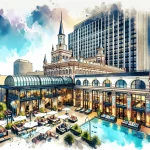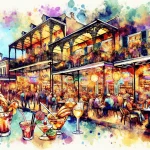The Fischer Housing Development in New Orleans’ Algiers neighborhood has played a significant role in the city’s urban landscape since its establishment in the 1960s. Originally consisting of over 1,000 housing units, this sprawling complex has undergone numerous transformations and faced various challenges, yet it stands as a testament to the resilience and determination of the local community, as well as ongoing efforts to provide affordable housing and revitalize the area.
In This Article
TL;DR
- The Fischer Housing Development has been a crucial part of New Orleans’ West Bank community since the 1960s, offering affordable housing to thousands of residents.
- The development faced challenges like crime, deterioration, and Hurricane Katrina’s impact but has undergone significant revitalization efforts in recent years.
- Current and future projects aim to improve residents’ quality of life, create employment opportunities, and foster community pride within the development.
Historical Context of Fischer Housing Development
Built in 1964-1965, the Fischer Housing Development was part of a nationwide effort to provide affordable housing for low-income families. Named after William J. Fischer, a former Housing Authority of New Orleans chairman, the original complex consisted of 14 low-rise buildings and a 13-story high-rise, totaling 1,002 housing units.
Influenced by the “Garden City” concept, the development’s design emphasized pedestrian-friendly environments and communal spaces. However, its isolated location, separated from other West Bank communities by the Mississippi River Bridge, the Donner Canal, and a Southern Pacific Railroad line, contributed to its eventual decline and reputation as a high-crime area.
The Fischer Housing Development was the last conventional public housing complex built in New Orleans before the shift towards mixed-income developments in the early 2000s, unlike other developments like Lafitte, St. Bernard, and Desire.
Architectural and Design Aspects
Community and Demographics
The Fischer Housing Development has been home to a predominantly African American community since its establishment. In 2000, the development had a population of 2,034 residents, 506 households, and 425 families. Following Hurricane Katrina and subsequent redevelopment efforts, the population decreased to 849 residents, 269 households, and 171 families as of the 2010 census.
The community has access to various social programs and amenities, including the William J. Fischer Elementary School (opened in 1967) and the Murray Henderson Elementary School (constructed in 1965). These schools, along with community centers and recreational facilities, have fostered a sense of community and provided educational opportunities.
Economic Impact
The Fischer Housing Development has had a significant impact on the local economy, both as a source of affordable housing and a generator of employment opportunities. The revitalization efforts, which began in the early 2000s, have attracted new businesses and services to the area, including retail stores, restaurants, and healthcare facilities.
The redevelopment process itself has created numerous construction and property management jobs, providing employment opportunities for local residents. As the Fischer Housing Development continues to evolve and grow, it is expected to play an increasingly important role in the economic development of the West Bank community.
Environmental and Sustainability Practices
The ongoing redevelopment of the Fischer Housing Development has incorporated various sustainable building practices and green initiatives. These efforts aim to reduce the development’s environmental impact, improve energy efficiency, and create a healthier living environment for residents.
Some of the sustainable features implemented in the new housing units include energy-efficient appliances, low-flow plumbing fixtures, and the use of eco-friendly building materials. The development also includes green spaces, community gardens, and tree-lined streets, which help to mitigate the urban heat island effect and improve air quality.
Future sustainability projects planned for the area include the installation of solar panels, the expansion of recycling programs, and the promotion of alternative transportation options, such as bike-sharing and electric vehicle charging stations.
Challenges and Controversies
Throughout its history, the Fischer Housing Development has faced numerous challenges and controversies. One of the most significant issues has been the high crime rate within the development, which peaked in the 1980s and 1990s. The complex gained national attention in 1980 when a police officer was murdered, leading to a violent raid by the New Orleans Police Department that resulted in the deaths of four residents and the indictment of several officers.
Other challenges have included the deterioration of the housing units, the concentration of poverty, and the isolation of the development from the surrounding neighborhoods. These issues were further exacerbated by the impact of Hurricane Katrina in 2005, which caused significant damage to the complex and displaced many of its residents.
In response to these challenges, local government officials and developers have implemented various solutions, including increased police presence, community policing initiatives, and the redevelopment of the complex into a mixed-income community. While these efforts have led to improvements in safety and quality of life, some residents and advocates have criticized the redevelopment process for displacing long-time residents and failing to provide adequate affordable housing options.
Future Prospects and Development Plans
The future of the Fischer Housing Development looks promising, with several new projects and initiatives in the works. The Housing Authority of New Orleans (HANO) and private developers are collaborating to create additional mixed-income housing units, as well as commercial and community spaces.
One of the most significant upcoming projects is the redevelopment of the former Fischer High School site, which will include a mix of affordable and market-rate housing, as well as a community center, a health clinic, and a grocery store. This project, along with others in the pipeline, aims to create a more vibrant, sustainable, and inclusive community.
Long-term goals for the Fischer Housing Development include increasing homeownership opportunities, attracting new businesses and services, and fostering a strong sense of community pride and engagement. As the development continues to evolve, it is expected to play a crucial role in shaping the future of New Orleans’ West Bank.
Impact on Local Culture and Community Life
The Fischer Housing Development has had a profound impact on the local culture and community life of the West Bank. Despite the challenges it has faced, the development has been home to generations of families who have contributed to the rich cultural heritage of New Orleans.
The development has been the site of numerous community events, festivals, and celebrations over the years, including the annual Fischer Family Day, which brings together current and former residents to celebrate the community’s history and resilience. The Fischer Community Center serves as a hub for social, educational, and recreational activities, offering programs for youth, adults, and seniors.
The redevelopment of the Fischer Housing Development has also brought new amenities and facilities to the area, including parks, playgrounds, and sports fields. These spaces provide opportunities for residents to come together, build relationships, and engage in healthy activities, fostering a sense of community cohesion and pride.
Expert Insights and Opinions
Urban planners, architects, and local government officials have weighed in on the significance of the Fischer Housing Development and its role in shaping the future of New Orleans’ West Bank.
“The redevelopment of the Fischer Housing Development represents a unique opportunity to create a more equitable, sustainable, and thriving community,” says Lisa Mazique, a local urban planner. “By incorporating mixed-income housing, community amenities, and green spaces, we can build a model for inclusive urban development that benefits all residents.”
Architects involved in the redevelopment process emphasize the importance of creating a built environment that reflects the community’s needs and aspirations. “Our goal is to design housing and community spaces that are not only functional and efficient but also inspire a sense of pride and belonging,” notes Michael Johnson, a lead architect on the Fischer High School redevelopment project.
Community leaders and residents also express hope and optimism for the future of the Fischer Housing Development. “I’ve lived in Fischer for over 30 years, and I’ve seen the ups and downs,” says Tamara Jackson, a long-time resident and community activist. “But I believe in the power of our community to come together, to support one another, and to build a better future for our children and grandchildren.”
As the Fischer Housing Development continues to evolve and grow, it remains a vital part of New Orleans’ West Bank community, a testament to the resilience and determination of its residents, and a symbol of the ongoing efforts to create a more equitable and sustainable urban landscape.






